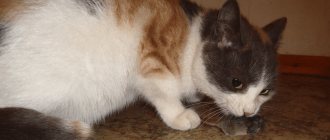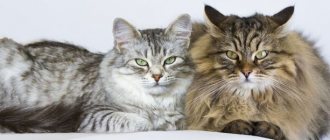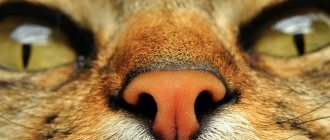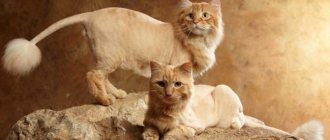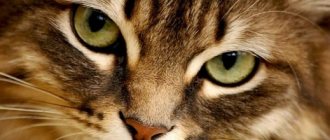The structure and location of vibrissae in male cats
Vibrissae are not hairs. They are much thicker, denser and longer. On average, the length of one cat's antennae is five to seven centimeters. Usually the length of the hairs is equal to the width of the cat's body. Unlike wool, “antennas” do not protect the kitty from cold and heat. Vibrissae on the muzzle play a completely different and no less important role.
Each cat's whisker has a curious structure and is connected to a specific part of the cat's brain. Signals received from the antennae allow the pet to formulate a complete picture of what is happening around in its head. So, these hairs consist of several elements - visible and invisible to the eye:
- invisible parts are nerve endings, cutaneous glands and skin;
- the visible part is the vibrissae itself.
The cat's whiskers are mobile due to the connective tissue bag, which contains the hair root, as well as striated muscles. The cat is able to move its antennae, direct them forward or, conversely, press them to its muzzle.
The thickness of a cat's antennae is determined by the many nerve endings and also depends on the sex of the animal. The abundance of nerve endings forms a small tubercle at the base of each hair.
The condition of the whiskers directly depends on the correct care of the pet. Cats that receive the required portion of vitamins, minerals and other beneficial components have “antennae” that are always fuller and longer.
Is it possible to trim them?
Under no circumstances should the whiskers be trimmed; without this important sense organ the cat:
- unable to adequately assess the size of holes, will begin to get stuck in them;
- will often become disorientated and fall;
- will not be able to adequately assess the distance between objects.
It is known that sometimes a mother cat personally chews off the whiskers of her most active kittens so that they are calmer.
Fortunately for cats, even if someone trims their whiskers or they lose them in a fight or get burned, after some time they will grow back , like the rest of the wool. Problems with restoration can only arise when the follicle itself that holds the mustache is damaged.
The so-called whiskers are of great importance for our pets. If you want cats to feel comfortable, take care of these tough growths. Do not touch or damage them with your hands. This will save the cat’s physical and mental health.
Why do cats and cats need whiskers and eyebrows?
A popular question, the answer to which not all owners of furry kisuls know. And whiskers actually mean a lot to cats. Scientifically speaking, vibrissae are modified organs of touch. If you look at the dictionary, the Latin word “vibrissae” literally means “to vibrate.” The follicles of the pussy's mustache and eyebrows contain a huge number of nerve endings. Thanks to the high sensitivity of the vibrissae located on the cheeks and eyebrows, cats “catch” air currents emanating from surrounding objects. This information is instantly transmitted to the brain.
If we take a closer look at the functions of the whiskers on the cheeks and eyebrows of cats, and what abilities whiskers give to cats, we can make a whole list:
- They help the cat determine the distance and size of objects. The cat correlates the information received with its size in order to make one decision or another.
- With the help of antennae and eyebrows, the cat navigates in space. Moreover, he does this both in the light and in the dark. In the dark, a kitty sees much better than a human. And their main assistant in this is the mustache.
- With the help of whiskers, the cat gets acquainted with new things. With new objects, with a new person or animal. The cat approaches an unfamiliar object, extending its “antennas” forward.
- Determination of temperature, atmospheric pressure and humidity level. Kitties feel changes in the listed indicators. If you watch a kitten as it “measures” the temperature of the environment, you will notice a slight movement of the whiskers and eyebrows. The vibrissae, which are located on the paw pads, are responsible for determining the temperature of surfaces.
- In addition, the cat uses its antennae in the area of the eyebrows and cheeks to estimate the wind speed and its direction. This information helps him calculate the force of the jump and model its trajectory.
- Eye protection. When any object touches the eyebrow whiskers, the cat automatically closes its eyes.
- Determining information about food, assessing its quality. Surely all owners have noticed that cats always sniff the bowl before they start eating from it. This way they learn what is in the feeder. The cat's whiskers near the nose and on the cheeks are responsible (for the most part) for this.
- Whiskers help mousetrap cats monitor the condition of the caught prey while it is held in their teeth.
The same functions are performed by the whiskers on the kitten's cheeks. Regardless of age, this tactile organ is necessary for a cat to live a full life.
What are the consequences of cutting a cat's whiskers?
Considering that the whiskers play a vital role in the life of any cat, cutting them off can lead to unpleasant consequences for the animal. Thus, according to the results of observations and research, cats and kittens whose whiskers have been cut off face the following problems:
- Deterioration of orientation in space. The animal can no longer obtain complete information about the world, since it is deprived of a tactile organ. This leads to a loss of coordination: the cat constantly crashes into everything, climbs into openings that are too narrow and gets stuck in them. In addition, the kitty begins to jump poorly. She falls before reaching her target.
- Closedness, irritation. The cat may hide in a corner and react uncertainly to what is happening.
However, not every cat faces such problems. Some cats do not change their behavior at all after losing their antennae. Outdoor cats suffer especially, since they cannot hunt without whiskers or protect themselves from dangers.
It is permissible to cut off a cat's whiskers only if there are injuries or infection of nearby tissues. But only a veterinarian should do this.
Cat's whisker tongue
If the animal is in a calm state, then its whiskers are relaxed
An attentive owner may notice that the pet's whiskers are in different positions. If a cat's whiskers are pressed to its muzzle, it means that it is scared of something or is worried about something. This situation also indicates that the animal is angry and may show aggression.
If your pet's coarse hair points forward, it means he is curious or ready to interact. When he sleeps, his muzzle with mustache is relaxed. Knowing these subtleties will help you determine when you need to play with your cat or calm him down.
Why do whiskers fall out and break in cats?
A healthy cat's whiskers can fall out on their own, since they also have a lifespan. If the owner notices a couple of whiskers that have fallen out, there is no need to worry. They left the hair follicle due to natural reasons. A new one will soon grow in their place.
But if you find a lot of dropped whiskers, you need to identify the cause. In most cases, the hair becomes brittle and often falls out due to normal stress, dehydration of the cat's body, and poor nutrition. The lack of microelements also affects the condition of the pet’s coat: it becomes dull and also falls out.
Pathological causes of vibrissae loss, leading to the death of hair follicles, include:
- Folliculitis. This disease involves inflammation of the hair follicles. As a rule, it is caused by various bacteria or viruses.
- Fungus. If a fungal infection affects the “whiskered” area, the whiskers begin to actively fall out along with the fur. Additionally, this area is very itchy.
- Skin diseases. These include demodicosis, lichen, dermatitis, etc. Due to skin diseases, the skin becomes inflamed and irritated, which leads to loss of the kitty's whiskers.
- Infestation with parasites. Helminths or ectoparasites (for example, fleas, ticks) affect the condition of the pet's coat and its health.
- Diseases of the endocrine system. This also includes diabetes and hypothyroidism.
Loss of whiskers
Throughout their lives, cats completely change their whiskers several times. In place of the fallen ones, new ones necessarily grow, then they darken, die, fall out, and the process begins again.
Main reasons
If the loss of whiskers increases and the shift cycle shortens, the owner needs to pay attention to the living conditions of his pet in order to eliminate the cause. They may be as follows:
- In the cold season, when the owners begin to heat the room, air humidity drops and this has a bad effect on the condition of the whiskers, so it is recommended to humidify the air in various ways to improve the living conditions of pets.
- Cats are very clean animals, but sometimes people think that their pet needs help cleaning its fur. Unnecessary bathing, especially frequent, can lead to dry skin, itching, irritation, allergic reactions, even hair loss, so you should think several times before bathing your cat again.
- Changes in hormonal levels. Moving, separation from the owner, adolescence and other factors can negatively affect the condition of the mustache; in this case, consultation with a specialist is necessary.
- Some fearless cats love to admire the fire and simply singe the tips of their whiskers, so you should not leave an open fire unattended.
- Dehydration. Your pet must always have clean and fresh water in sufficient quantities. As you know, in the wild, the cat family will never drink where they dine, as the water may be poisoned, so if you notice that the animal is not drinking or drinking insufficient quantities, you can use this trick and place a bowl of water away from food.
- Lack of nutrients. If there is a deficiency of vitamins and minerals, the cat will have problems not only with its whiskers, but also with its health in general. The mustache will fall out, break, and may stop growing. It is imperative to contact a veterinarian so that he can select a diet for the animal’s speedy recovery. Food should be fresh, varied, have no chemical additives, and not be salty, sweet or sour. You should not give expired food or “yesterday’s” leftovers. You need to choose high-quality, proven brands that contain the vitamins and minerals your cat needs to maintain a healthy body.
Possible diseases
The problem with loss and brittleness of the whiskers is not always a consequence of poor animal husbandry: in some cases, these symptoms indicate an allergic reaction in the body. The most common foods that cause allergies are milk, chicken, fish, and food additives. In addition to problems with the whiskers, the cat develops itching, watery eyes, rashes on the skin, and hair may also fall out.
The problem with whisker loss can also indicate very serious diseases occurring in the animal’s body:
- Diseases of the endocrine system. It is divided into 2 types: hypothyroidism - a syndrome in which there is a decrease in the concentration of thyroid hormones. Hyperthyroidism is a clinical condition in which the thyroid gland overproduces the thyroid hormones triiodothyronine and thyroxine. The first signs of the development of one of the diseases are a sharp change in the animal’s weight, as well as thinning and loss of hairs, including whiskers.
- With the development of diabetes mellitus, the problem of vibrissae loss is also observed.
- Skin diseases. Dermatitis, fungal diseases, infections and other skin problems that cause irritation and itching can lead to hair and whisker loss.
- Various parasites that can settle on the animal’s body and inside the body can also cause vibrissae loss due to a decrease in general immunity, so it is recommended to regularly treat your pet for parasites.
Help for a cat that has lost its whiskers
Any problems associated with a cat's whiskers are not only caused by harmless reasons. They often indicate the development of a serious illness in a cat.
Prevention of antennae loss consists of a small list of measures, which include:
- Air humidification in the apartment. Excessively dry air negatively affects the health of the cat.
- Proper feeding of a mustachioed pet. Regular intake of essential nutrients into the cat’s body maintains and strengthens its health and, accordingly, the condition of its whiskers. It is also important to change your pet's water daily. A drinking bowl should be freely available.
- Timely treatment against ectoparasites and helminths.
- Vaccination on time.
- Refusal to self-medicate kitty.
In a word, if a cat lives in comfortable conditions and receives adequate nutrition, he will not face problems with whiskers. But if your cat continues to lose its whiskers, and their general condition has noticeably worsened, you should consult a veterinarian as soon as possible. This is a clear symptom that indicates a problem in the cat’s body. An experienced veterinarian will definitely send the animal for tests and prescribe a specific course of treatment. Treatment will be aimed at eliminating the disease that leads to the loss of antennae in the pussycat.
On the part of the owner, strict adherence to the veterinarian’s instructions, implementation of prescribed recommendations and therapeutic procedures is required. As a rule, the cat is sent home for treatment. But in severe cases, hospital stay is required. If you follow your doctor's instructions, the effect of treatment will come very quickly.
Treatment and prevention methods for mustache problems
Create comfortable living conditions for your cat
By taking care of the health of your furry resident every day, you can avoid hair loss. Monitor the humidity in the room. To keep the room dry, we recommend purchasing and installing a humidifier. Try to provide the animal with plenty of fluids. At the same time, the water in his bowl should always be clean. Feed your cat high-quality food. Do not forget about the vitamin and mineral complexes that your pet needs.
If you are going to give raw fish to your tailed fish, we recommend that you first heat-treat the product.
When caring for your pet, use high-quality and proven products. Carry out the necessary vaccinations and deworming. If necessary, treat the fur against parasites. But under no circumstances cut your pet’s hair, and also do not self-medicate. Do not treat a broken mustache with any preparation. Try to create comfortable living conditions so that your four-legged friend does not experience stress.
If you notice that your cat is losing a lot of its coarse hairs, immediately try to find out the reason for this process. And take all measures to eliminate the problem. But first, contact your veterinarian. The specialist will examine the animal, study its test results and prescribe the necessary treatment. Follow your veterinarian's recommendations and your cat will recover quickly.
Questions and answers
Does a cat grow whiskers?
Yes, they are growing. And not just around the nose. They are located above and near the eyes, on the chin, on the paws (for example, on the pads). In total, there are about forty antennae on the cat’s body, 24 of which grow on the face.
Why do cats need mustaches?
Vibrissae are necessary for cats to determine the distance to a particular object, to orient themselves in space, to study an unfamiliar object, and to determine the temperature of the environment. In addition, the antennae protect the eyes of the small predator and help it navigate in pitch darkness.
Interesting facts about mustaches
- The system of pressure on the antennae can create a feeling of anxiety in them, so use a wide plate or flat feeder to eat.
- In addition to a dozen hairs that are located on different sides of the nose, there are rather short analogues that are located near the eyes, near the chin, and on the other side of the paws in front.
- The size of the hairs is such that they are literally similar to the width of the body, so they can figure out the width of the holes for themselves without even trying to pass through it.
- The placement of the mustache can be balanced by different moods. If they are completely relaxed and straightened in different directions, then the cat feels calm. If they are turned forward, it means there is anxiety.
- Without whiskers, cats may become disoriented and experience headaches, thereby not receiving vital signals.
